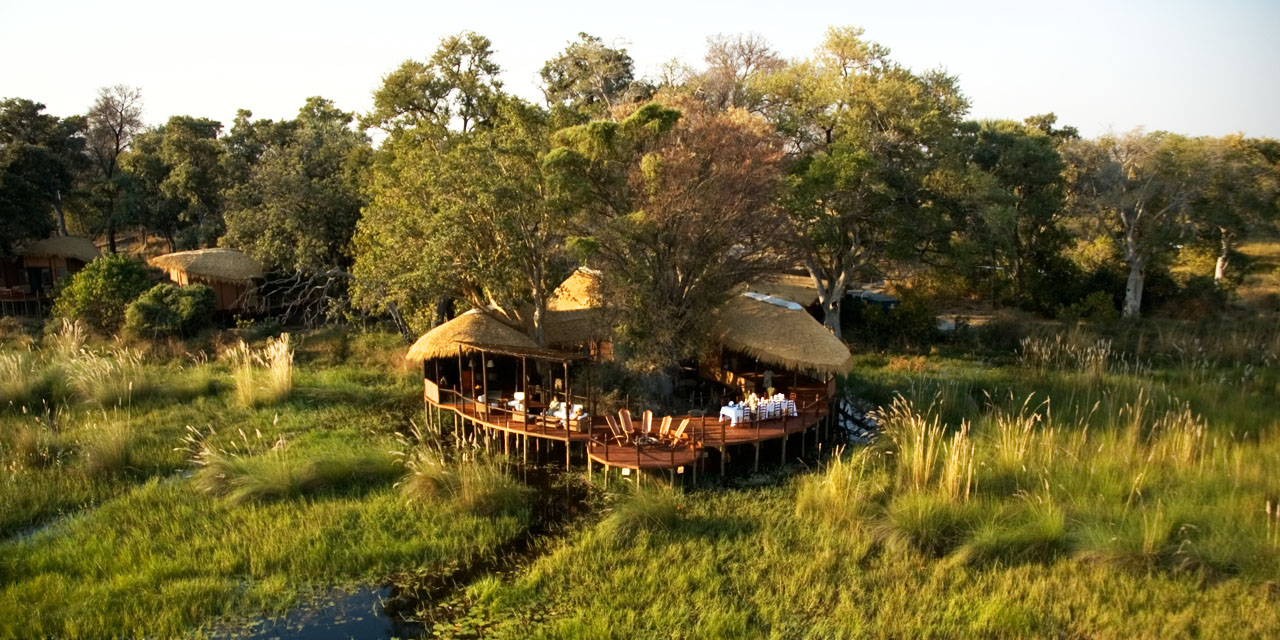Baine’s Camp
Baines’ Camp was built in 2005 in a beautiful area of Botswana’s Okavango Delta: neighbouring the Moremi Game Reserve and facing the Boro River, one of the Delta’s main arteries. Named after the famed Victorian explorer and artist, Thomas Baines, the camp is notable for its innovative construction, the opportunity to walk with elephants and its ever-popular roll-out ‘star beds’.
Baines’ Camp stands shares a concession with its larger sister camp, Stanley’s Camp . Baines’ Camp itself is a lovely, intimate camp with just five suites (three twins and two doubles), with thatched roofs and ‘solid’ walls made from recycled drinks’ cans and plaster containing elephant dung – unusual, but the finished effect is novel and much smarter than the ingredients might suggest!
The bedrooms feature four-poster beds, draped with mosquito nets, which can be rolled out onto your private deck beneath the stars if you are interested in this option. These decks overlook the river at the front of each suite, with a couple of chairs and a table to enjoy the outdoors during the day. Just inside each suite is a seating area with a very comfortable lounge chair, and on the opposite wall is a copy of one of Thomas Baines’ famous paintings, set on an easel. There are plug points set on the bottom of the wall adjacent to the lounge chair for charging and, unusually for an Okavango camp, a small hairdryer is provided. A small minibar is typically stocked with water and a few soft drinks, but you have only to ask and the team will stock it with your preferred drinks.
In the en-suite bathroom, his and hers washbasins stand next to an ample-sized indoor shower, and a toilet within a separate cubicle.
During the evenings, an outdoor bubble bath is drawn for guests in a traditional metal bathtub on the deck. Branches of large fever-berry trees are placed on the deck to set the outdoor ambience, and a floor mat and comfortable slippers are also provided.
Raised wooden walkways connect Baines’ Camp’s suites to the relatively small main area. Built on raised wooden decking around a large termite mound, it incorporates a comfortable lounge and small library, overlooking a perennial lagoon, where hippos can often be seen wallowing (and heard snorting!). The dining area is open-sided, although in suitable weather meals may be taken on the deck under the stars. Unusually for a camp in the Okavango, there is no bar, so drinks need to be ordered from a member of staff; should nobody be around, you could have to wait. A well-stocked cabinet serves as a curio shop
Built away from the main area, between rooms 3 and 4, there is a lovely plunge pool with a sundeck and loungers, as well as two shady ‘salas’. Thoughtfully, the camp has provided a fridge well-stocked with refreshments.
*For a full list of available activities, the best time of the year to visit, and any other relevant enquiries, please contact a Sister Hippo Travel Consultant!









